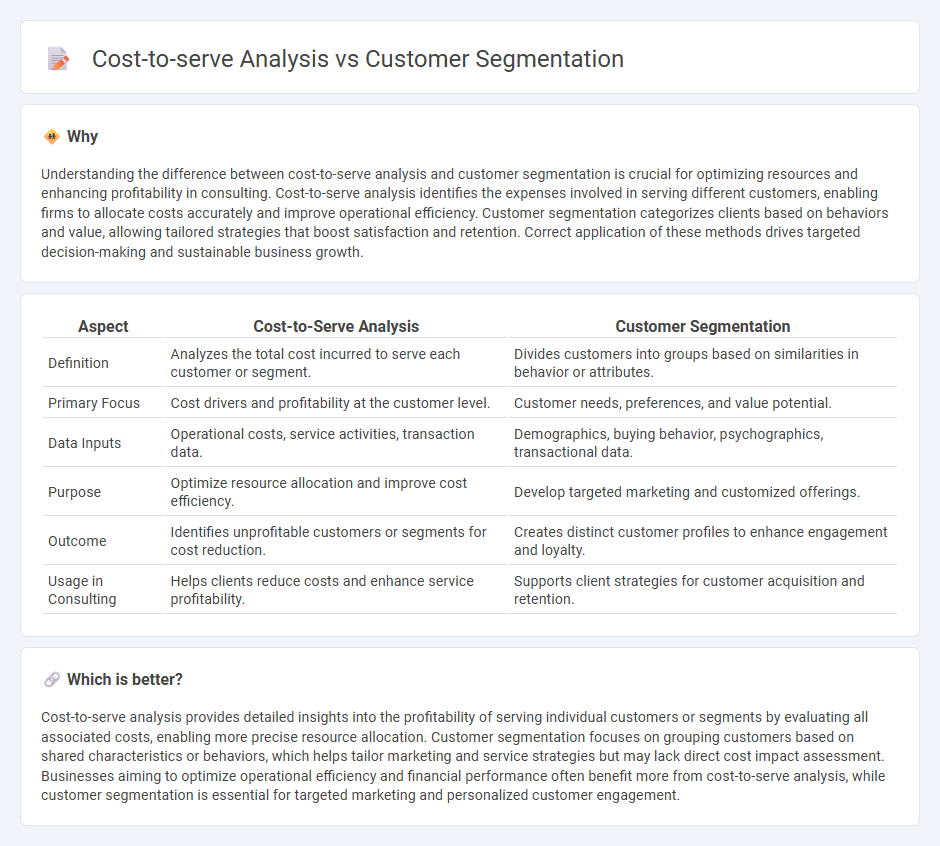
Cost-to-serve analysis identifies the true expenses associated with serving each customer or segment, highlighting profitability variations across the client base. Customer segmentation groups clients based on characteristics like behavior, value, and demographics to tailor strategies for improved service and sales. Explore how integrating cost-to-serve analysis with customer segmentation drives precision in resource allocation and profitability enhancement.
Why it is important
Understanding the difference between cost-to-serve analysis and customer segmentation is crucial for optimizing resources and enhancing profitability in consulting. Cost-to-serve analysis identifies the expenses involved in serving different customers, enabling firms to allocate costs accurately and improve operational efficiency. Customer segmentation categorizes clients based on behaviors and value, allowing tailored strategies that boost satisfaction and retention. Correct application of these methods drives targeted decision-making and sustainable business growth.
Comparison Table
| Aspect | Cost-to-Serve Analysis | Customer Segmentation |
|---|---|---|
| Definition | Analyzes the total cost incurred to serve each customer or segment. | Divides customers into groups based on similarities in behavior or attributes. |
| Primary Focus | Cost drivers and profitability at the customer level. | Customer needs, preferences, and value potential. |
| Data Inputs | Operational costs, service activities, transaction data. | Demographics, buying behavior, psychographics, transactional data. |
| Purpose | Optimize resource allocation and improve cost efficiency. | Develop targeted marketing and customized offerings. |
| Outcome | Identifies unprofitable customers or segments for cost reduction. | Creates distinct customer profiles to enhance engagement and loyalty. |
| Usage in Consulting | Helps clients reduce costs and enhance service profitability. | Supports client strategies for customer acquisition and retention. |
Which is better?
Cost-to-serve analysis provides detailed insights into the profitability of serving individual customers or segments by evaluating all associated costs, enabling more precise resource allocation. Customer segmentation focuses on grouping customers based on shared characteristics or behaviors, which helps tailor marketing and service strategies but may lack direct cost impact assessment. Businesses aiming to optimize operational efficiency and financial performance often benefit more from cost-to-serve analysis, while customer segmentation is essential for targeted marketing and personalized customer engagement.
Connection
Cost-to-serve analysis and customer segmentation are interconnected as they enable businesses to identify the profitability of different customer groups by evaluating the specific costs incurred in serving each segment. This connection helps optimize resource allocation and tailor service strategies to improve overall efficiency and customer satisfaction. By aligning cost structures with distinct segments, companies can enhance decision-making and drive targeted growth.
Key Terms
Customer Segmentation Criteria
Customer segmentation criteria typically include demographic factors, purchasing behavior, geographic location, and psychographic profiles, enabling businesses to tailor marketing strategies and enhance customer engagement. Cost-to-serve analysis focuses on quantifying expenses associated with serving different customer segments, highlighting profitability variations and operational efficiency. Explore detailed methodologies and benefits of each approach to optimize customer targeting and resource allocation.
Cost Allocation Models
Customer segmentation categorizes clients based on behaviors and value to tailor marketing strategies effectively. Cost-to-serve analysis utilizes cost allocation models to assign accurate service expenses to each customer segment, revealing true profitability. Explore how integrating these approaches enhances strategic decision-making and optimizes resource allocation.
Profitability Analysis
Customer segmentation divides a market into distinct groups based on purchasing behavior, demographics, or preferences to tailor marketing and sales strategies effectively. Cost-to-serve analysis quantifies the actual expense incurred in serving each customer segment, highlighting profitability differences often masked by traditional revenue metrics. Explore deeper insights into how these approaches synergize to optimize profitability analysis.
Source and External Links
What Is Customer Segmentation? | Definition from TechTarget - Customer segmentation is the practice of dividing a customer base into groups with similar characteristics like demographics, interests, or behavior to deliver personalized marketing and improve sales conversion rates.
What is Customer Segmentation? - Customer segmentation organizes customers into groups based on shared traits such as demographic, psychographic, geographic, or behavioral factors to better target marketing and improve customer experience.
Customer Segmentation Meaning & Analysis Models | Optimove - Customer segmentation strategies use data analytics and machine learning to group customers by behavior, preferences, and value, enabling precise targeting and predictive marketing to boost engagement and revenue.
 dowidth.com
dowidth.com